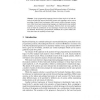Free Online Productivity Tools
i2Speak
i2Symbol
i2OCR
iTex2Img
iWeb2Print
iWeb2Shot
i2Type
iPdf2Split
iPdf2Merge
i2Bopomofo
i2Arabic
i2Style
i2Image
i2PDF
iLatex2Rtf
Sci2ools
ENTCS
2000
2000
Forward and Backward Chaining in Linear Logic
Abstract. Logic programming languages based on linear logic are of both theoretical and practical interest, particulaly because such languages can be seen as providing a logical basis for programs which execute within a dynamic environment. Most linear logic programming languages are implemented using standard resolution or backward chaining techniques. However, there are many applications in which the combination of such techniques with forward chaining ones are desirable. We develop a proof-theoretic foundation for a system which combines both forms of reasoning in linear logic.
| Added | 18 Dec 2010 |
| Updated | 18 Dec 2010 |
| Type | Journal |
| Year | 2000 |
| Where | ENTCS |
| Authors | James Harland, David J. Pym, Michael Winikoff |
Comments (0)

